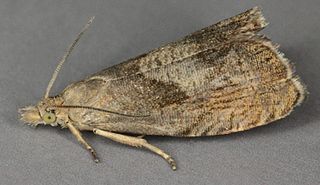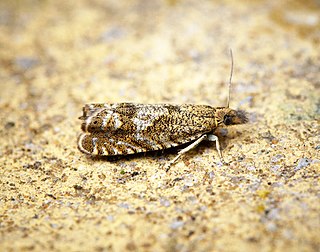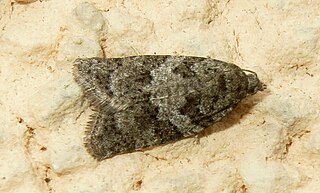
Dichrorampha acuminatana is a moth of the family Tortricidae. It is found in Europe and the Near East.

Dichrorampha simpliciana is a moth of the family Tortricidae. It is found in Europe and the Near East.

Dichrorampha is a genus of moths belonging to the subfamily Olethreutinae of the family Tortricidae.

Dichrorampha alpinana, the broad-blotch drill, is a species of moth of the family Tortricidae. It is found in almost all of Europe.

Dichrorampha vancouverana, the tanacetum root moth, is a moth of the family Tortricidae.

Rhopobota stagnana is a moth belonging to the family Tortricidae. The species was first described by Michael Denis and Ignaz Schiffermüller in 1775.

Lobesia reliquana is a moth belonging to the family Tortricidae. The species was first described by Jacob Hübner in 1825.

Cydia coniferana is a Palearctic moth belonging to the family Tortricidae. The species was first described by Saxesen in 1840. The wingspan is 11-13 mm. The forewings are dark fuscous, the costa posteriorly with white strigulae, some ending in obscure leaden-metallic marks. There is an irregular erect white dorsal median spot, including a dark fuscous strigula. The ocellus is edged with leaden-metallic, and crossed by several black dashes. The hindwings are fuscous. The larva is dull yellowish ; head pale brown

Ancylis unguicella is a moth belonging to the family Tortricidae. The species was first described by Carl Linnaeus in his landmark 1758 10th edition of Systema Naturae.

Pammene ochsenheimeriana is a moth belonging to the family Tortricidae. The species was first described by Friederike Lienig and Philipp Christoph Zeller in 1846.
Dichrorampha agilana is a moth belonging to the family Tortricidae first described by Johan Martin Jakob von Tengström in 1848.

Dichrorampha consortana is a moth belonging to the family Tortricidae. The species was first described by James Francis Stephens in 1852.
Dichrorampha flavidorsana is a moth belonging to the family Tortricidae subfamily Olethreutinae Tribe Grapholitini first described by Henry Guard Knaggs in 1867.
Dichrorampha incognitana is a moth belonging to the family Tortricidae. The species was first described by Jerzy Kremky and Maslowski in 1933.
Dichrorampha obscuratana is a moth belonging to the family Tortricidae first described by Wolff in 1955.

Dichrorampha plumbagana is a moth belonging to the family Tortricidae first described by Georg Friedrich Treitschke in 1830.

Dichrorampha plumbana is a moth belonging to the family Tortricidae first described by Giovanni Antonio Scopoli in 1763. It is native to the Palearctic including Europe.
Dichrorampha senectana is a moth belonging to the family Tortricidae first described by Achille Guenée in 1845.
Dichrorampha sylvicolana is a moth belonging to the family Tortricidae. The species was first described by Hermann von Heinemann in 1863.

Cnephasia genitalana is a butterfly belonging to the family Tortricidae. The species was first described by Pierce and Metcalfe in 1915.














